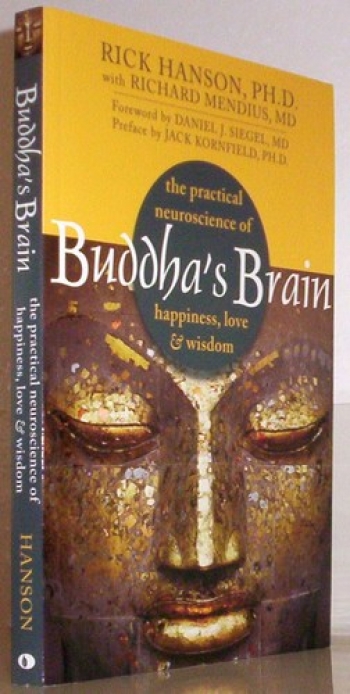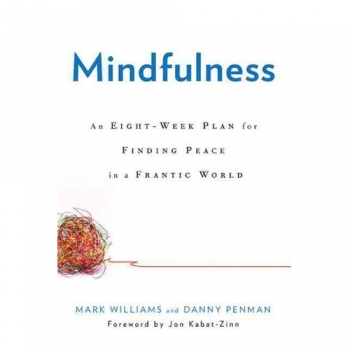 Buddha's Brain. From Amazon.
Buddha's Brain. From Amazon. Mindfulness: An Eight-Week Plan for Finding Peace in a Frantic World. From Ebookee.
Mindfulness: An Eight-Week Plan for Finding Peace in a Frantic World. From Ebookee.We all know that life is suffering - but why do we suffer? And when we spend ten minutes sniffing, examining, chewing, and finally mindfully eating a raisin, what exactly happens to our brains? These questions are raised in two new books, which function like CAT scans, peeling back the mystery to reveal the physical skeleton behind Buddhism. Buddha’s Brain, by Rick Hanson with Richard Mendius, and Mindfulness: An Eight-Week Plan for Finding Peace in a Frantic World, by Mark Williams and Danny Penman, find a lovely fulcrum, balancing between religion and modern medicine.
On the cover of Buddha’s Brain, the author’s Ph.D. certifications dangle above the serene face of a meditating Gautama. The design serves an overall message of uniting scientific research with the spiritual path. The authors don’t just want to show you how to meditate - they want to show you why meditation works. This unique desire to explain, rather than convince, relies on expertise of neuroscientists and neuropsychologists, who have been studying meditation’s effects on the brain.
Hanson and Mendius unpack meditation in terms of diagnosis and treatment. First, they explain why modern brains are racing and stressed, talking through evolutionary fight-or-flight responses and the role of neurotransmitters in maintaining hyper-alert states. Each chapter contains asides with charts, drawings of the brain, and explanations of hormones and synapses. When you can actually see how the brain is affected by a stressful encounter - and the physical healing created by a mindfulness practice - meditation ceases to be an abstract concept. It becomes another physical process, like digestion, easy to understand and easier to control.
Hanson draws from the Four Noble Truths to structure the book. He opens with an explanation of why life involves suffering, but from your brain’s point of view. The brain is a dynamic system, Hanson asserts, constantly preparing for what comes next by manufacturing a chemical called serotonin. However, neurons in your brain constantly fire and empty their serotonin, needing to refill immediately. This is a delicate, ongoing process of hoarding, spending, and more hoarding, Hanson points out: “Too much inhibition and you’ll
feel numb inside; too much arousal and you’ll feel overwhelmed... Most of this regulation stays out of your awareness. But some signals for corrective action are so important they bubble up into your consciousness.” We experience these signals as craving - a need for food, sleep, or safety - and respond to them to help restore balance to the brain. But there’s always a new threat or a new craving, and that’s suffering. Hanson then relates our body’s regulatory functions to tanha, the Pali root word for craving, deftly drawing neuroscience back into the world of Buddhist philosophy.
The writers sum up their major findings at the end of each chapter, bulleting the key points. Because they cover so much ground in each chapter, these summaries are valuable tools. I found myself going back and re-reading the summaries when I forgot the role of the amygdala in decision making, or how the parasympathetic nervous system related to stress response.
If that vocabulary sounds overwhelming, it’s really not; Hanson breaks down the brain in easy parts. For instance, he begins the chapter titled “Love” by discussing spindle cells, small groups of neurons that support social interaction. It’s hardly the most romantic introduction, but Hanson quickly moves beyond the physical process. Spindle cells provide evolutionary advantage (for example, apes that employ those social neurons and work together tend to survive better). Even better, the spindles also serve as our empathy circuits, Hanson writes. In short, these monkey-survival instincts provide our capacity for love.
Mindfulness: An Eight-Week Plan for Finding Peace in a Frantic World has a slightly different focus. Built as a program of increasingly intensive practice, Williams and Penman’s advice entails less explaining and more doing. The reader must embark on a series of guided meditations, each accompanied by a chapter of explanation. With conversational, clear prose, the chapters lay out the case for mindfulness, using examples from other practitioners who have taken the eight-week course. Each week builds on the next, through creatively-named practices such as “The Intensely Frustrating Line Meditation” and “The Befriending Meditation,” with the expectation that in the end, the reader will move in the world just a bit differently.
Like Buddha’s Brain, Mindfulness employs plenty of sidebars and explanatory boxes, but it focuses on the psychological, rather than neuroscientific, aspects of mindfulness practice. It also includes a helpful audio portion, accessible online, with guided meditations.
For a new meditator, Mindfulness is perhaps is a better book, as it scaffolds the process and sets up habits; in contrast, the meditations in Buddha’s Brain sometimes felt like mere illustrations of concepts, rather than lifelong practices. However, the specific physical-to-mental correlations given in Buddha’s Brain helped solidify ideas I’d heard many times before, but never quite understood.
The Western upbringing teaches us not to trust what we can’t dissect. For that reason, the scientific perspective in these books creates a sense of confidence and trust in the mindfulness approach. The authors of both Mindfulness and Buddha’s Brain do a careful job of deconstructing what is often seen as exotic, mystical, and unscientific, revealing mindfulness as a deeply practical method.
Both books draw from Buddhism, but they can sound more like a doctor’s prescription than an offshoot of a 2,500-year-old religion. In fact, Buddhism - rich in ritual, tradition, and cultural context - sometimes gets sidelined in favor of the science. Whereas meditation may sound onerous or Buddhism foreign and esoteric to a Western audience, mindfulness has a sturdy, scientific sound to it - and the books focus on that terminology, forsaking most religious allusion and paring down the concepts to their cores. Religions and traditions evolve as they cross cultural boundaries. Look at yoga, the Hindu spiritual path that is now a selling point of any chain gym membership. Meditation and Buddhism may be undergoing a similar transformation as they become better known in the West - moving from religious practice to something less bound by ritual and more culturally neutral. As the practice changes us, we are altering the practice as well. Mindfulness feels that way in these two books: something familiar, yet utterly new.
















